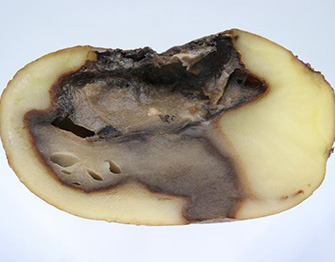Please click here to access the main AHDB website and other sectors.
- Home
- Knowledge library
- Watery wound rot
Watery wound rot

Watery Wound Rot or Leak is a vigorous rot of lifted tubers caused by the fungus - like water mould - Pythium ultimum. It is widespread and common but only occasionally serious in a crop.
Symptoms
Affected flesh can be discoloured grey through to brown with a dark margin. It is moist and quickly liquefies. A fresh cut can smell alcoholic or, if more advanced, fishy. Tubers can end up entirely liquefied in a bag of skin but sometimes an inner rot does not spread outward beyond the vascular ring leaving hollowed remnants of cortex. Pythium mycelia are not seen by the naked eye. Secondary infections are extremely likely and can confound diagnosis.
Conditions
This pathogen is common in soil but requires damage to allow pathogen entry. Warm harvests exacerbate the problem.
Control
Serious outbreaks are hard to predict but certainly avoid fields with a history of the disease. Ensure a good skin set and avoid harvesting in wet conditions, especially if also warm. Minimise harvest damage. Dry curing, positive ventilation and immediate temperature pull down inhibit the spread of disease.

